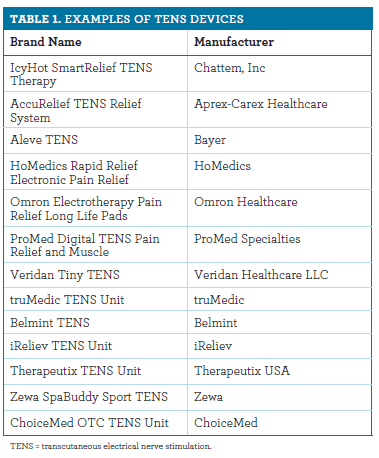Publication
Article
Pharmacy Times
OTC TENS Devices: Managing Joint and Muscle Pain
Author(s):
Since the 1970s, transcutaneous electrical nerve stimulation devices have been used by various health care providers for the management and treatment of muscle and joint pain.
Since the 1970s, transcutaneous electrical nerve stimulation (TENS) devices have been used by various health care providers—such as chiropractors, physical therapists, and physicians—for the management and treatment of muscle and joint pain.1 In recent years, the FDA has approved TENS devices, meant for nonprescription use, as class II medical devices for the relief of pain associated with sore, aching muscles; joint pain; or chronic intractable pain.1,2 Several TENS devices are available over the counter to temporarily relieve pain caused by exercise strain or normal household and work activities. The pain relief delivered by these TENS devices is believed to have a 2-fold effect: alteration of pain transmission and increase in the production of natural endorphins.1,3
TENS is currently recognized as one of the most frequently used forms of electro-analgesia, and various studies have investigated the potential benefits of TENS devices for temporary pain relief.3 Moreover, TENS devices are portable—about the size of a credit card—and provide patients with relief from muscle and joint pain without the worry of the adverse effects often associated with the use of analgesics. TENS devices can also be used discreetly while patients engage in daily activities, and the intensity level can be individualized to suit a patient’s particular pain relief needs.4,5 The devices are typically used for 15- to 30-minute intervals, up to 3 times daily, or as directed.1,4,5
Consumers can find a host of TENS devices in drugstores and online (Table 1) in a variety of sizes, and they are generally reasonably priced, ranging from $30 to $100. Manufacturers design them with unique features, such as a compact size, remote operation, wireless technology, or replaceable electrode gel pads. One of the most well-known nonprescription TENS devices on the market is IcyHot's SmartRelief TENS Therapy System (Chattem, Inc), which is designed to target a particular area of pain, such as back and hip or knee and shoulder pain.4 These units have 63 customizable intensity levels, with automatic shut-off after each 30-minute session, replaceable batteries for easy use, and portability.4

The latest TENS device hit the consumer market in July 2016: the Aleve Direct Therapy TENS device (Bayer).5 According to the manufacturer, Aleve Direct Therapy is recommended for the temporary relief of pain associated with sore and aching muscles in the lower back due to strain from exercise or normal household and work activities.5 This new device uses a patented 3-stage waveform technology to provide pain relief in the lower back for 30 minutes.5 The first stage involves high-frequency stimulation for 5 minutes, the second stage delivers a gentle tapping sensation to stimulate an increased endorphin release to decrease sensitivity to pain for 20 minutes, and the last stage is comparable to the first stage, delivering high-frequency stimulations to maintain the feeling of pain relief for 5 minutes.5 Bayer states that treatment may be repeated throughout the day, as needed, with 30-minute breaks between sessions.5 The device is battery operated, remotely controlled, and adjustable to 15 intensity levels.5
PATIENT COUNSELING
The TENS pain relief devices on the market provide patients with another viable option for managing and treating pain without the adverse effects associated with many oral and topical analgesics. Patients should be advised to always thoroughly read all directions prior to using these devices and reminded to adhere to manufacturer warnings and precautions.4,5 Although TENS devices are considered safe for most consumers, some significant contraindications, precautions, and warnings exist; these are listed in Table 21,2,4,5.

Patients with preexisting medical conditions should always consult their primary health care providers before using TENS devices to ascertain appropriateness of use. During counseling, patients should be advised to contact their primary health care provider with any questions or concerns, especially if their pain worsens or does not improve. Some patients may experience skin irritation on the areas under the electrode gel pads, in which case they should discontinue use until they have consulted their primary health care provider.2,4,5 Patients should also be directed to manufacturer websites to view the user manuals and obtain answers to frequently asked questions.
Ms. Terrie is a clinical pharmacist and medical writer based in Haymarket, Virginia.
References
- Olenak J. Musculoskeletal injuries and disorders. In: Krinsky D, Berardi R, Ferreri S, et al, eds. Handbook of Nonprescription Drugs. 18th ed. Washington, DC: American Pharmacists Association; 2015.
- Anson P. New wearable devices for chronic pain. Pain New Network website. painnewsnetwork.org/stories/2015/9/14/wearable-devices-for-chronic-pain. Accessed June 30, 2016.
- Kaye V. Transcutaneous electrical nerve stimulation. Medscape website. emedicine.medscape.com/article/325107-overview. Updated December 9, 2015. Accessed June 1, 2016.
- Smart Relief TENS Pain Relief Therapy user manual. SmartRelief website. smartrelief.com/wp-content/uploads/2015/08/IH_SmartRelief_Inst_Manual.pdf. Accessed June 1, 2016.
- Aleve Direct Therapy user manual. Aleve website. aleve.com/aleve-direct-therapy/static/documents/ADTTD_Product_Manual-Approved_Labeling.pdf. Accessed June 1, 2016.







